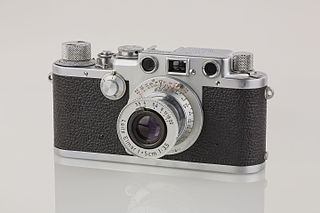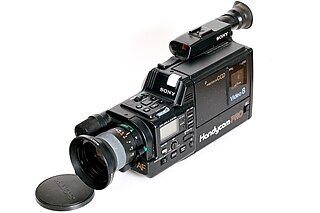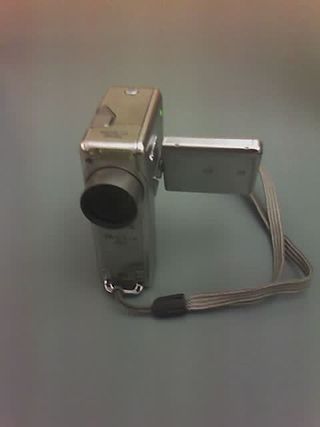Related Research Articles

A camera is an instrument used to capture and store images and videos, either digitally via an electronic image sensor, or chemically via a light-sensitive material such as photographic film. As a pivotal technology in the fields of photography and videography, cameras have played a significant role in the progression of visual arts, media, entertainment, surveillance, and scientific research. The invention of the camera dates back to the 19th century and has since evolved with advancements in technology, leading to a vast array of types and models in the 21st century.

A digital camera, also called a digicam, is a camera that captures photographs in digital memory. Most cameras produced today are digital, largely replacing those that capture images on photographic film or film stock. Digital cameras are now widely incorporated into mobile devices like smartphones with the same or more capabilities and features of dedicated cameras. High-end, high-definition dedicated cameras are still commonly used by professionals and those who desire to take higher-quality photographs.

A camcorder is a self-contained portable electronic device with video and recording as its primary function. It is typically equipped with an articulating screen mounted on the left side, a belt to facilitate holding on the right side, hot-swappable battery facing towards the user, hot-swappable recording media, and an internally contained quiet optical zoom lens.

A camera phone is a mobile phone which is able to capture photographs and often record video using one or more built-in digital cameras. It can also send the resulting image wirelessly and conveniently. The first commercial phone with color camera was the Kyocera Visual Phone VP-210, released in Japan in May 1999.

A digital single-lens reflex camera is a digital camera that combines the optics and mechanisms of a single-lens reflex camera with a solid-state image sensor and digitally records the images from the sensor.

Sigma Corporation is a Japanese company, manufacturing cameras, lenses, flashes and other photographic accessories. All Sigma products are produced in the company's own Aizu factory in Bandai, Fukushima, Japan. Although Sigma produces several camera models, the company is best known for producing high-quality lenses and other accessories that are compatible with the cameras produced by other companies.

A stereo camera is a type of camera with two or more lenses with a separate image sensor or film frame for each lens. This allows the camera to simulate human binocular vision, and therefore gives it the ability to capture three-dimensional images, a process known as stereo photography. Stereo cameras may be used for making stereoviews and 3D pictures for movies, or for range imaging. The distance between the lenses in a typical stereo camera is about the distance between one's eyes and is about 6.35 cm, though a longer base line produces more extreme 3-dimensionality.

A full-frame DSLR is a digital single-lens reflex camera (DSLR) with a 35 mm image sensor format. Historically, 35 mm was one of the standard film formats, alongside larger ones, such as medium format and large format. The full-frame DSLR is in contrast to full-frame mirrorless interchangeable-lens cameras, and DSLR and mirrorless cameras with smaller sensors, much smaller than a full 35 mm frame. Many digital cameras, both compact and SLR models, use a smaller-than-35 mm frame as it is easier and cheaper to manufacture imaging sensors at a smaller size. Historically, the earliest digital SLR models, such as the Nikon NASA F4 or Kodak DCS 100, also used a smaller sensor.

Image stabilization (IS) is a family of techniques that reduce blurring associated with the motion of a camera or other imaging device during exposure.

Sony Corporation produces professional, consumer, and prosumer camcorders such as studio and broadcast, digital cinema cameras, camcorders, pan-tilt-zoom and remote cameras.

This article details lensesfor single-lens reflex and digital single-lens reflex cameras. The emphasis is on modern lenses for 35 mm film SLRs and for "full-frame" DSLRs with sensor sizes less than or equal to 35 mm.

The Canon PowerShot TX1 is a Canon digital camera. It was released on February 22, 2007 The TX1 is a hybrid device designed for both still imagery and video recording. It offers both HDTV movie capture, as well as 10× stabilized zoom and 7.1 megapixel sensor. It is designed to improve upon hybrid offerings by competitors such as the Sony Cyber-shot M1, Sony Cyber-shot M2, and Pentax MX4. It is oriented vertically and uses the camcorder-like swivel LCD viewing screen. Canon compares the hybrid camera's size to that of the Canon ELPH series of cameras. The company distinguishes the camera for its optical image stabilizer technology, DIGIC III image processor, face detection technology and red-eye effect correction with a mention of its built-in lens cover and scratch-resistant, anti-reflective LCD screen.

The Micro Four Thirds system is a standard released by Olympus Imaging Corporation and Panasonic in 2008, for the design and development of mirrorless interchangeable lens digital cameras, camcorders and lenses. Camera bodies are available from Blackmagic, DJI, JVC, Kodak, Olympus, OM System, Panasonic, Sharp, and Xiaomi. MFT lenses are produced by Cosina Voigtländer, Kowa, Kodak, Mitakon, Olympus, Panasonic, Samyang, Sharp, Sigma, SLR Magic, Tamron, Tokina, TTArtisan, Veydra, Xiaomi, Laowa, Yongnuo, Zonlai, Lensbaby, Venus Optics and 7artisans amongst others.

The Pentax K-x is a 12.4 megapixel digital single-lens reflex camera, which was announced on September 16, 2009. The Pentax K-x uses a Sony Exmor sensor. In some cases it even approaches the quality produced by full-frame DSLRs like the Nikon D700 and the Canon 5DMkII, both with larger sensors. The Pentax K-x is suitable for low light conditions for both still and video photography.

A mirrorless camera is a digital camera which, in contrast to DSLRs, does not use a mirror in order to ensure that the image presented to the photographer through the viewfinder is identical to that taken by the camera. They have come to replace DSLRs, which have historically dominated interchangeable lens cameras. Other terms include electronic viewfinder interchangeable lens (EVIL) cameras and compact system cameras (CSCs).

The E-mount is a lens mount designed by Sony for their NEX and ILCE series of camcorders and mirrorless cameras. The E-mount supplements Sony's α mount, allowing the company to develop more compact imaging devices while maintaining compatibility with 35mm sensors. E-mount achieves this by:
A 3D camcorder can record 3D video.
References
- ↑ "OSS vs. Image Stablization[sic]: Sony Alpha / NEX E-mount (APS-C) Talk Forum: Digital Photography Review". www.dpreview.com. Retrieved 2019-06-23.
- ↑ "This Teardown of a Sony E-Mount Lens Shows Optical SteadyShot in Action". petapixel.com. 9 February 2016. Retrieved 2019-06-23.
- ↑ "Lens Stabilization vs In-camera Stabilization". Photography Life. 20 February 2012. Retrieved 2019-06-23.